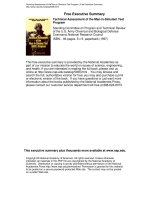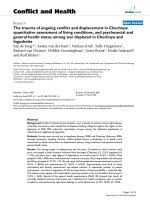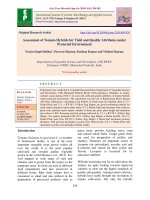Assessment of macro-nutrient status of pear orchards in Jammu and Kashmir, India
Bạn đang xem bản rút gọn của tài liệu. Xem và tải ngay bản đầy đủ của tài liệu tại đây (115.8 KB, 5 trang )
Int.J.Curr.Microbiol.App.Sci (2017) 6(6): 2720-2724
International Journal of Current Microbiology and Applied Sciences
ISSN: 2319-7706 Volume 6 Number 6 (2017) pp. 2720-2724
Journal homepage:
Original Research Article
/>
Assessment of Macro-Nutrient Status of Pear Orchards
in Jammu and Kashmir, India
Sartaj A. Wani1*, G.R. Najar1, Farida Akhter1, Bilal A. Padder2 and Masarat Maqbool1
1
Division of Soil Science, Faculty of Agriculture, SKUAST-K, Wadura, Sopore,
J & K-193201, India
2
Division of Fruit Science, SKUAST-K, Shalimar - 190 025, Srinagar, J & K, India
*Corresponding author
ABSTRACT
Keywords
Correlation,
Macronutrients,
Pear orchards,
Soil properties.
Article Info
Accepted:
26 May 2017
Available Online:
10 June 2017
A reconnaissance survey was conducted to determine the macronutrient status of pear
(Pyrus communis L.) growing orchards of district Pulwama in Kashmir during 2014-15. A
total of thirty six soil samples collected from each surface and sub-surface depths of
twelve representative profiles were analyzed for physico-chemical properties and
macronutrients. Results of the soil chemical analysis revealed that none of the surveyed
pear orchards was deficit in available macronutrients and were medium in available N
(292.88-414.67 kg ha-1) and P (10.09-17.51 kg ha-1), medium to high in K (246.73-280.40
kg ha-1) and Ca (2010-2475 ppm), low to medium in Mg (264.30-294.80 ppm) and S
(9.24-12.15 ppm) status respectively. In the present study the correlation studies showed
that soil pH had significant influence on N, P, Ca and S availability. Organic carbon
showed significantly positive correlation in surface (N=0.603*), P (P=0.379*) and
(K=0.414*) and sub-surface (N=0.747*), (P=0.429*) and (K=0.634*) soils respectively.
Addition of sufficient organic matter and proper nutrient management practices may serve
better for improving soil properties thereby enhancing the nutrient availability.
Introduction
The pear native of Central Asia, stands 2nd in
ranking after apples as the most important
delectable tree fruits, is grown in all the
continents of the world under warm temperate
to temperate climatic conditions. Due to very
high chilling requirements, the superior
cultivars of pear (Pyrus communis) are
confined to high hills of Jammu and Kashmir,
Himachal Pradesh and Uttaranchal in India.
The state of Jammu and Kashmir offers
favourable agro-ecological potential for pear
cultivation. Currently the area under pear fruit
is 13883 ha with annual production of 54847
MT in our state (Anonymous, 2015). The low
pear production is primarily owing to the poor
soil fertility status besides improper
management practices. The crop production
and soil managements greatly differ with kind
of soil and their physico-chemical behavior
(Sharma et al., 2006). The production of
quality fruit is also influenced by the fruit
mineral composition, harvesting at maturity
stage and leaf fruit ratio. The nutrient
supplying power of a soil depends on
dissociation of the nutrients from the
exchange site, which is in turn depend on the
degree of saturation of the nutrients on the
exchange site, type
of
clay and
complementary ion-effect (Foth and Ellis,
1997). Continued removal of nutrients, with
2720
Int.J.Curr.Microbiol.App.Sci (2017) 6(6): 2720-2724
little or no replacement has aggravated the
potential for future nutrient related plant
stress and yield loss. It is therefore, inevitable
to consider the analysis assessing the
nutritional availability of fruit growing crops
with deep and ramified root system (Najar et
al., 2005). Besides, knowledge of nutrient
distribution down the profile is important to
evaluate the contributions of different subsurface horizons. The excessive and repeated
use of specific nutrient fertilizer has lead to
nutritional imbalances through the decline of
other
necessary nutrients.
Nutritional
imbalances in the soil cause nutritional
disorders and consequently affect both quality
and quantity of fruits. A study has been
therefore, conducted in pear growing orchards
to determine the status of available
macronutrients as well relationship with soil
physico-chemical properties so as to use such
knowledge as a tool in optimizing fertilizers
use for better yield and quality.
Materials and Methods
Soil profiles were exposed in three
established physiographic zones viz., high,
mid and low altitudes respectively from
twelve representative pear (Pyrus comunis L.)
orchards of uniform age group (15-30 years)
in Pulwama district of Jammu and Kashmir.
Stratified random soil sampling was preferred
due to large number of pear orchards present
in this region. The soil samples collected at
collected at surface and sub-surface (0-30cm
and 30-90cm) depths respectively were air
dried, crushed with wooden pestle and mortar
and passed through 0.2 mm sieve. The
processed composite soil samples were
analyzed for physico-chemical properties and
available macro-nutrients using standard
procedure by Jackson (1973) and piper
(1966). The available N, P, K, Ca, Mg and S
were determined by methods outlined by their
standard procedures. The concentration of
calcium and magnesium in the extract was
determined
by
atomic
absorption
spectrophotometer (AAS). The available
status of N, P, K, Ca, Mg and S were
categorized in sufficient and deficient
categories by considering their critical limits
as given by Subbiah and Asija (1956), 280 Kg
ha-1 for N; Olsen et al., (1954), 8.96 Kg ha-1
for P, Hanway and Heidal (1952), 98.56 Kg
ha-1 for K; and Kanwar and Mohan (1964), 10
ppm for S respectively. Simple correlation
coefficients
were
computed
relating
macronutrients with different physicochemical properties (Panse and Sukhatame,
1967).
Results and Discussion
All the surface soil samples at 95% CI, were
medium in available N (292.88-414.67), P
(10.09-17.51) and Mg (264.30-294.80),
medium to high in available K (246.73280.40 kg ha-1) and Ca (2010-2475) and low
to medium in available S (9.24-12.15 ppm)
with the average values of 357.33, 14.81,
277.60, 263.05 kg ha-1, 2267.50 and 10.92
ppm respectively. In case of sub-surface soils
at 95% CI, content varied from 191.98-245.60
N, 10.02-11.39 P, 206.49-219.06 K 2141.602417.89 Ca, 259.65-274.78 Mg and 8.979.91S ppm with average values of 218.78,
10.71, 213.51kg ha-1, 2279.7, 267.22 and 9.44
ppm respectively (Table 1). Similar results for
macronutrient status were reported by Dar et
al., (2012) while studying the pear orchards in
Kashmir. In the present study, macronutrients
like N, P, Mg and S showed significant
difference (using t-test at p<0.05) between
surface and sub-surface soil depths.
Macronutrients like N, P and S were
significant and negatively related with pH in
both surface and sub-surface soils with
correlation coefficients as shown in table 2.
The availability of phosphorus decreases with
increase in soil pH because of its conversion
into insoluble tricalcium phosphates. Similar
2721
Int.J.Curr.Microbiol.App.Sci (2017) 6(6): 2720-2724
relationship between pH and available
phosphorus was reported by Najar (2005) and
Dar et al., (2012). Significant and positive
relationship between soil pH and calcium
(0.579* and 0.524*) indicates the basic nature
of calcium. Such findings were reported by
Wani (2001) and Dar et al., (2012). Nonsignificant but negative correlation of EC
with macronutrients was reported by Khokhar
et al., (2012). A significant and positive
correlation of organic carbon with N, P and K
was observed in both surface (0.603*, 0.379*
and 0.414*) and sub-surface (0.747*, 0.429*
and 0.634*) soils indicated that organic matter
contributed to the major fraction of these
nutrients. The increase in available nitrogen
could be attributed to the association of
nitrogen with organic matter and adsorption
of NH4-N by humus complexes in soils.
Table.1 Depth-wise distribution of available macronutrients pear orchards
Location
Tujan
Rohomu
Newa
Khrew
Newa
Bundzoo
Chakora
Urcherso
Katibug
h
Pampore
Pahu
Gundbag
Surface
P
K
0-30
30-90
0-30
30-90
0-30
30-90
0-30
30-90
0-30
30-90
0-30
30-90
0-30
30-90
0-30
30-90
0-30
30-90
N
(kg ha-1)
408.80
273.38
414.67
250.74
394.91
264.26
381.80
284.12
373.14
231.72
360.46
218.87
349.08
195.64
329.84
208.18
345.36
191.28
17.00
12.13
13.14
9.92
17.20
11.68
15.85
12.05
15.74
11.38
17.51
11.98
14.13
9.43
11.77
9.85
15.26
10.86
0-30
30-90
0-30
30-90
0-30
30-90
292.88
181.21
324.48
167.08
312.57
158.92
Average
95%CI
Average
95%CI
357.33
292.88-414.67
218.78
191.98-245.60
Depth
(cm)
Mg
S
271.44
228.01
265.43
216.91
280.40
216.02
278.98
217.32
267.37
214.58
250.64
202.18
257.17
211.81
260.12
226.44
255.48
20.4.69
Ca
(ppm)
2114
2063
2410
2214
2010
2369
2252
2449
2148
2029
2475
2234
2334
2622
2290
2253
2180
1878
285.90
257.6
275.70
282.72
278.40
264.16
264.30
272.43
289.56
282.00
283.65
287.10
276.94
254.12
294.80
270.13
268.74
259.23
9.24
9.76
11.78
10.13
10.65
8.74
12.15
9.00
11.00
10.03
11.90
9.98
10.38
8.84
10.12
8.30
11.74
10.40
11.78
10.0
12.72
9.84
10.09
9.38
260.42
212.56
246.73
192.25
262.42
210.53
2325
2282
2242
2427
2430
2537
272.54
267.8
276.35
251.7
264.38
257.63
11.02
9.70
10.00
8.37
10.38
10.05
14.81
10.09-17.51
10.71
10.02-11.39
263.05
246.73-280.40
213.51
206.49-219.06
2267.5
2010-2475
2279.70
2141.60-2417.89
277.60
264.30-294.80
267.22
259.65-274.78
10.92
9.24-12.15
9.44
8.97-9.91
0.068
0.343
0.017
0.001
Subsurface
Surface
0.0001
p-value 0.0001
Subsurface
95%CI = Confidence Interval at 95 per cent
2722
Int.J.Curr.Microbiol.App.Sci (2017) 6(6): 2720-2724
Table.2 Relationship between physico-chemical properties and
Available macronutrients of tested pear orchard soil samples
Surface soils (0-30)
Nutrient
pH
EC
N
- 0.577* -0.564
P
-0.623*
-0.490
K
-0.123
-0.382
Ca
0.579*
0.287
Mg
-0.314
0.322
S
-0.489*
-0.457
* Significant at 5 per cent level
Sub-surface soils (30-90)
OC
CaCO3
(%)
Clay
pH
EC
OC
0.603*
0.379*
0.414*
-0.312
0.216
0.115
-0.614*
-0.421
-0.507*
0.468*
0.369*
-0.058
-0.053
-0.146
0.125
0.233
0.058
0.007
-0.767*
-0.643*
-0.428*
0.524*
-0.333
-0.502*
-0.384
-0.133
-0.158
0.088
0.007
-0.156
0.747*
0.429*
0.634*
-0.147
-0.298
0.399
Similar results were earlier reported by Najar
et al., (2006), Dar (2012) and Singh &
Rathore (2014). The increase in availability of
nitrogen, phosphorus and sulphur may be
attributed to the release of these elements
from organic complexes as well as from the
weathering of minerals containing due to
acidulating action of organic matter. These
results are in conformity with the findings of
Wani (2001), Farida (2005) and Singh &
Rathore (2014). Calcium carbonate showed
significantly negative relationship with
nitrogen and potassium in surface and subsurface soils and with phosphorus (-0.346*)
and sulphur (-0.474*) in sub-surface soils
only. Similar relationship was earlier reported
by Najar (2005) and Dar et al., (2012).
Significant but positive correlation of calcium
carbonate with calcium and magnesium
results from increase in pH due to calcium
carbonate thereby increasing calcium and
magnesium. Such findings were reported by
Wani (2001) and Dar et al., (2012).
Considering
the
critical
limit
of
macronutrients, the studied orchards are
100% medium in available N, P, Ca and Mg,
8% high in available K and 17% low in
available S. Although S was low in some
orchards, all other pear orchard soils were
adequate in available macronutrients. The
results further indicated that the soil pH and
OC play major role in controlling the
CaCO3
(%)
-0.480*
-0.346*
-0.424*
0.397*
0.451*
-0.474*
Clay
0.320
0.152
0.512
-0.476
-0.054
0.014
availability of macronutrients. These factors
could be manipulated in order to combat any
present
or
future
deficiencies
of
macronutrients in these soils.
References
Anonymous 2015. Area and production of
horticultural crops in Jammu and
Kashmir
State.
Department
of
Horticulture. J&K Government.
Dar, M. A., Wani. J. A., Raina, S. K, Bhat M.
Y., Dar. M. A. 2012. Effect of available
nutrients on yield and quality of pear
fruit Bartlett in Kashmir Valley, India.
Journal of Environmental Biology.
33:1011-1014.
Farida, A. 2005. Studies on relationship
between fruit yield and quality with soil
and leaf nutrient content in apple
orchards of Zangier block of district
Baramulla Kashmir. Ph. D thesis
submitted
to
SKUAST-Kashmir,
Srinagar, pp 117.
Foth, H.D. and Ellis, B.G. 1997. Soil fertility,
2nd Ed. Lewis CRC Press LLC., USA.
290p. Kanwar, J.S. and Mohan, S. 1964.
Distribution of forms of sulphur in
Punjab
soils.
Symposium
on
Fertilization in Indian Soils. Bulletin
National Institute of Science, India 20:
31-36.
Hanway, J.J. and Heidel, H. 1952. Soil
2723
Int.J.Curr.Microbiol.App.Sci (2017) 6(6): 2720-2724
analysis methods as used in Iowa State
College soil testing laboratory. Iowa
State College of Agriculture Bulletin 57:
1-31
Jackson, M.L. 1973. Soil Chemical Analysis.
Prentice Hall of India Private Limited,
New Delhi.
Khokhar, Y., Rattanpal, H. S., Dhillon, W. S.,
Singh, G. and Gill, P. S., 2012. Soil
fertility and nutritional status of Kinnow
orchards grown in aridisol of Punjab,
India. African Journal of Agricultural
Research 7: 4692-4697.
Lindsay, W.L. and Norwell, W.A. 1978.
Development of DTPA soil test of
ascertaining available Fe, Cu, Mn and
Zn. Soil Sci. Soc. Amer.J. 42: 421-27.
Najar, G.R., Akhtar, F. and Rahman, F.H.
2005. Mineral nutrient status of Apple
orchards of Kashmir. SKUAST Journal
of Research 7(2): 271-275.
Olsen, S.R. and Sommers, L.E. 1982.
Phosphorus. Methods of soil analysis,
Part 2, pp 403-430.
Panse, V.G. and Sukhatame, P.V. 1967.
Statistical Methods for Agricultural
Workers. Indian Council of Agricultural
Research, New Delhi
Piper, C.S. 1966. Soil and Plant Analysis. 5th
edition. Hans Publisher, Bombay, p
464.
Sharma, V. K., Dwivedi, K. S., Tripathi, D.
and Ahmed, Z. 2006. Status of available
major and micronutrients in the soils of
different blocks of Leh district of cold
arid region of Ladakh in relation to soil
characteristics. Journal of the Indian
Society of Soil Science 54: 248-250.
Singh, D. P. and Rathore, M.S. 2014.
Available nutrient status and their
relationship with soil properties of
Aravalli mountain ranges and Malwa
Plateau of Pratapgarh, Rajasthan, India.
African Journal of Agricultural
Research 8(41): 5096-5103.
Subbiah, B.V. and Aaija, G.L. 1956. A rapid
procedure for the estimation of
availability nitrogen in soils. Current
Science 25: 259-260.
Wani, G.N. 2001. Studies on the distribution
of secondary nutrient elements (Ca, Mg
and S) in apple orchard soils of north
Kashmir.
Thesis
submitted
to
SKUAST-Kashmir, pp. 75.
How to cite this article:
Sartaj A. Wani, G.R. Najar, Farida Akhter, Bilal A. Padder and Masarat Maqbool. 2017.
Assessment of Macro-Nutrient Status of Pear Orchards in Jammu and Kashmir, India.
Int.J.Curr.Microbiol.App.Sci. 6(6): 2720-2724. doi: />
2724









